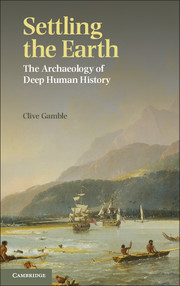Book contents
- Frontmatter
- Dedication
- Contents
- List of boxes
- List of figures
- List of tables
- Acknowledgements
- Glossary
- Web resources for skulls and stone tools
- 1 The worlds of deep human history
- 2 The drivers of climate and environment: Terrae 0–2, 10Ma–50ka
- 3 The recent veneers of climate, environment and population: Terrae 3–5, 50ka to the present day
- 4 Walking and running down the tectonic trail: Terra 0, 10–3.3Ma, and Terra 1, 3.3–1.8Ma
- 5 Three strides across a bio-tidal world: Terra 2, 1.8Ma–50ka
- 6 Going beyond, keeping in touch: Terra 3, 50–4ka
- 7 The call of the north: Terra 3, 50–4ka
- 8 Eyes on the horizon: Terra 4, 4–1ka
- 9 The human reunion in retrospect: Terra 5, after 1400 AD
- Bibliography
- Index
5 - Three strides across a bio-tidal world: Terra 2, 1.8Ma–50ka
Published online by Cambridge University Press: 05 June 2014
- Frontmatter
- Dedication
- Contents
- List of boxes
- List of figures
- List of tables
- Acknowledgements
- Glossary
- Web resources for skulls and stone tools
- 1 The worlds of deep human history
- 2 The drivers of climate and environment: Terrae 0–2, 10Ma–50ka
- 3 The recent veneers of climate, environment and population: Terrae 3–5, 50ka to the present day
- 4 Walking and running down the tectonic trail: Terra 0, 10–3.3Ma, and Terra 1, 3.3–1.8Ma
- 5 Three strides across a bio-tidal world: Terra 2, 1.8Ma–50ka
- 6 Going beyond, keeping in touch: Terra 3, 50–4ka
- 7 The call of the north: Terra 3, 50–4ka
- 8 Eyes on the horizon: Terra 4, 4–1ka
- 9 The human reunion in retrospect: Terra 5, after 1400 AD
- Bibliography
- Index
Summary
It is one thing to allow that a given migration is possible and another to admit there is good reason to believe it has really taken place.
Thomas Huxley, Man’s Place in Nature, 1863Hominins on the Move
Terra 2 is a world of expansion and contraction (Figure 5.1). Major geographical gains occur with large areas of Eurasia now settled for the first time. But the boundaries to further dispersal are rigid. No hominin crosses the comparatively short ocean distance from Indonesia to Australia, and elsewhere there is no significant expansion above 55°N. Indeed, the northern distribution of Terra 2 hominins looks very similar to the Pleistocene distribution of macaque monkeys (Figure 4.7).
Terra 2 sees a step change in the quantity and diversity of evidence. The varied hominins who inhabit and settle Terra 2 left behind an archaeology that is increasingly rich in quantity and variety. When scrutinised by archaeologists, it reveals there were technological changes to the stone tools, the novel use of materials for aesthetic enchantment, fire, ochre and shell, as well as evidence for new concepts such as containers and composite tools. By contrast, the fossil evidence remains patchy for much of Terra 2, its classification and interpretation often disputed. But this situation changes towards the end of this Terra with more abundant fossil data from Europe and Indonesia.
- Type
- Chapter
- Information
- Settling the EarthThe Archaeology of Deep Human History, pp. 141 - 187Publisher: Cambridge University PressPrint publication year: 2013



